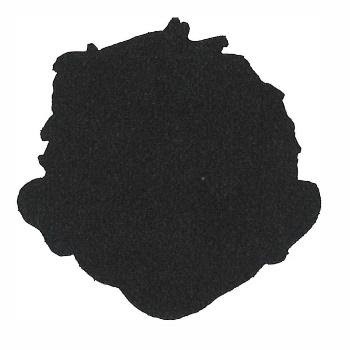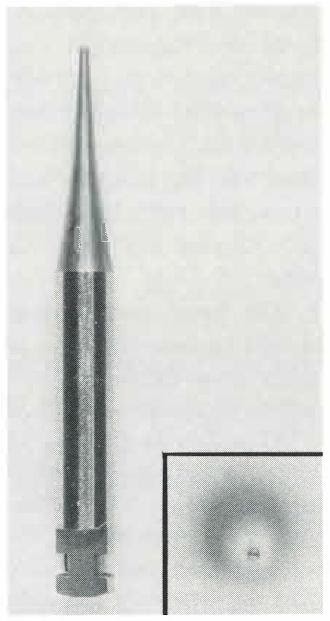W.B. EAMES (AUTUMN 1978), MINIMUM INSTRUMENTATION FOR CONSERVATIVE OPERATIVE PROCEDURES, OPERATIVE DENTISTRY, VOL 3(4), PP. 144-146
Minimum Instrumentation for Conservative Operative Procedures
*This paper has been rejected by all of the leading journals in dentistry and is printed here after a demand for equal time.

The inkblot means many things to many people.
Introduction
When Black (1908) described the proximo-occlusal cavity preparation, instruments and philosophies of tooth reduction were such that gross cutting of the occlusal was advocated for strength and retention of the restoration.
A departure from this concept was described by Bronner (1930), who conceived and advocated a new conservative proximo-occlusal preparation. This preparation has been both acclaimed and criticized by many clinical investigators and clinicians.
Markley (1964) described a technique for minimizing the occlusal entry by using a No ½ round bur with an ultraspeed handpiece—the premise being that the smooth shank cannot overcut the tooth. The preparation of the XXX cavity is then completed with other burs.
An extension of this concept was proposed by Sturdevant (1964), who has initiated the manufacture of a No ¼ round bur (Kerr Mfg Co, Romulus, MI 48174, USA). The use of this bur further points up the trend to greater conservation of tooth tissue in restorative dentistry.
Sequelae
It is here proposed that, to project the emphasis of conservative cutting to its utmost, the obvious instrument is the No 0, or 00, bur (Montebank Dental Mfg Co). The No 0 bur is indicated for the posterior teeth of adults and the No 00 bur for posterior deciduous teeth. These burs will hereafter be referred to as the aught series bur (Fig).
Since the bur consists of a shank without the conventional head, it is suggested that the clinician use only the nondentated form, thus eliminating one more element of divective surface interphase.
.

FIGURE Axial view of aught series (headless) bur, useful in the conservative preparation of congenitally missing teeth, is shown to eliminate one element of divective surface interphase. (Inset) End view exhibits the surface poiuyt, or froning, as shown in the phase of oberlappen, and is known to be a pogrin tider
The use of the aught series bur has been extended into many areas:
The most obvious operation for routine use is the preparation of congenitally missing teeth and deciduous teeth lost in playground altercations. It can further be used for the reduction of the fifth cusps of lower second molars and for the prophylactic odontotomy of the stained grooves of octogenarians that have not experienced previous dental caries.
A special use for the aught series bur is in removing clinically and radiographically nonevident caries—the bane of the enthusiasts of pit and fissure sealants. Its use has also been shown to eliminate the subsequent need for hand instrumentation.
Histologic studies have shown the No 0 bur virtually to eliminate adverse response of the pulp during abusive cutting, with or without air or water coolants. The bur has, in fact, been found to be useful even when operated digitally. This has greatly enhanced the recent effort for more effective expanded utilization of auxiliary personnel.
Method of Testing
An effort was made to examine the effect of the eccentricity of this bur. Only production specimens, proffered during dental meetings, were tested.
Rotational speeds from 500 to 400 000± 4 rev/min with an air turbine handpiece were used as standards for all tests.
A tooth section to be used as a control was first photographed in profile and tru-casts recorded on a gross Blancetnuit dichrometer, as described by Day (1961).
To satisfy the conditions of the experiment, it must be assumed that the relationship between the SRO and the planing time is inversely exponential. In such a case, the SRO becomes a positive hyperbolic function, exceeding the 95% level of confidence.
The aught series bur eliminates the tendency for stress concentration in which the instrument may reach its frennic limit. Planing an infinite Cortwait will also increase the value of another variable, (CH)I, defined by the following equation:

*By the sheerest coincidence, this formula, when pronounced phonetically, gives credence to the dim but firmly held suspicion of incredulity. -Ed.
Interpretation of Data
It can be seen that as ultra speeds were approached, the eccentric quiescent phases were absolved in the phase of oberlappen, as described by Wolfgang & others (1958). This phenomenon has been observed in almost total absentia, i.e., the fact that the nondentated characteristic of the aught series bur further obscures the true clinical impact of the Devinorm calculation.
The Pogrin Tider
A test analysis of variance was made of the degrees of probability. It was held that the consummate result clinically corroborates the view that the eccentricity as presently considered was tider or was, at the least, a pogrin tider.
I am not sure that I agree that the pogrin tider can be adopted as a universal parametric descriptor for specification purposes at this time. While the evidence is weighty, the statistical method employed, a one-way AOV, is of questionable applicability. It would have been much more convincing had Bartlett’s test been used since this method has proven so valuable in prior bur research, at least with pear-shaped burs.
Barry K Norling, PhD
Discussion and Conclusion
The climate of this study could be unjustifiably altered by those who are inclined to carry it to an unrealistic parameter. It has been suggested that the bur could be useful in the range of 0.0 or 0.00, and even the exaggerated 0.00-0 has been considered. These are not thought to be practical and it is strongly felt that there is no support for this premise. The author is, however, currently investigating the obscure concept of the shankless aught series bur. The manufacture of this bur has become a problem. The clinician can well appreciate the complexities of producing such instruments, in that the ideal material for this bur has not been found. The production costs cannot be borne over a long-range program, because normal replacement due to wear and change of design is obviated. Initial cost of instruments may understandably he abnormally high, but would, of course, be compensated by a liberal annual cost-use ratio obsolescence, which could be introduced by any competent economic adviser.
We have every reason to expect that the aught series bur may well provide the clinician with the ultimate in conservative operative nostrums—a real turkey.
The loss of a grant has obviated the exploration of new facets, but further studies need to be done.
References
BLACK, G V (1908) Operative Dentistry. Chicago: Medico-Dental Publ Co.
BRONNER, FINN J (1930) Engineering principles applied to class 2 cavities. Journal of Dental Research, 10, 115-119.
DAY, THYME 0 & KNIGHT, DEADO (1961) Bisexual behavior of the beetle nut weevil. Biodontographical Review, 49, 161.
MARKLEY, MILES R (circa 1964) Personal communication. Round Table Seminar-A Tax-deductible Consultant Conference. Los Angeles: Pink Pussy Cat.
STURDEVANT, CLIFFORD (circa 3/4:00 am) Personal communication. Chicago: Rush Street. Ibid.
WOLFGANG, RA, MESSERSCHMITT, MA & MEISTERBRAU, QUORTO (1958) Preparation av klass 11- kaviter. Odontologica Levi Strauss, 14, 92.
(Accepted 2 November 1977)
Inkblot: Alfred E Neuman© 1978 by E C Publications, Inc
Although the author refuses to be identified, reprints are reluctantly available in a plain, brown wrapper from Wilmer B Eames, DDS, Emory University, School of Dentistry, Atlanta, GA 30322, USA.